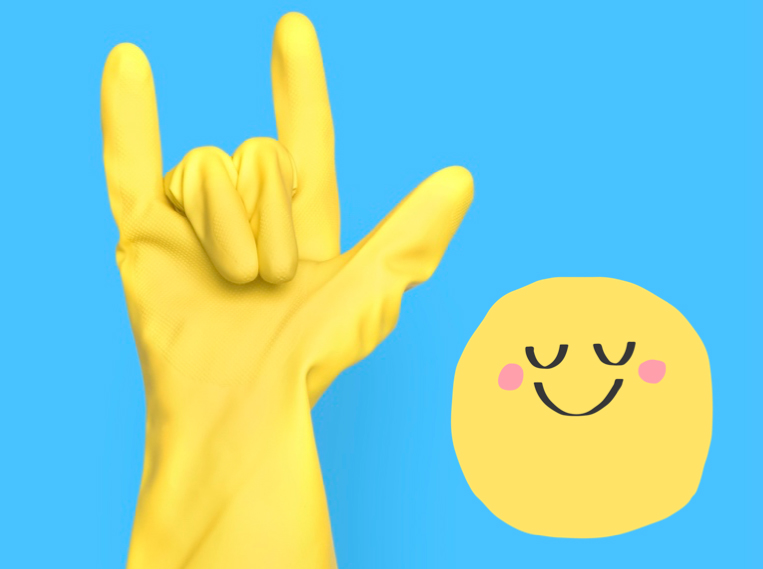
Do you have this nagging voice in your head that frequently says, “You should tidy your room”?
If your immediate reaction to this thought is “Ugh. I don’t wanna!”, I get it.
For most of my life, cleaning and tidying felt like something I should do.
I didn’t see the point of it.
I thought, “Why bother cleaning when it’s only going to get messy again?”
But over time, I’ve experienced a shift in my thinking. I’ve come to realise tasks such as cleaning, tidying, decluttering, and organising are critically important to staying focused and calm and achieving goals.
In this blog, I want to share a simple way to reframe tidying, cleaning, and organising. Rather than feeling like you’re burdened by an endless list of chores, this simple reframe will help to decrease psychological resistance. It will leave you feeling motivated to tackle your piles of mess.
No one is born a grub
Sometimes things happen in life that cause us to view ourselves in a particular way (e.g., “I’m a messy person” or “I’m the sort of person who leaves my work until the last minute”). These labels can be hard to shake. Here’s an example from my own life . . .
When I was in high school, I had a cooking teacher (Mrs S) who had a knack of making students feel really small.
I never cooked at home as a child, so I felt anxious and out of my depth in cooking class.
A lot of things went wrong in that class. I burnt my muffins and failed to present my food nicely when it was being assessed by Mrs S. I also broke a large ceramic mixing bowl at which point my cooking buddy swore out loud and the entire class went silent. We were mortified.
Yes, you could say these were great learning opportunities. But it certainly didn’t feel like it at the time.
Cooking class was something I came to fear. Why?
Mrs S was mean. She was particularly nasty and cruel with the way she delivered feedback.
She made Gordan Ramsey seem nice. Her comments were delivered in a tone of disgust and moral superiority. I remember one student breaking down in tears and crying the entire lunch break after receiving feedback from Mrs S.

Mrs S would say things like . . .
“Why is your place mat so far out? Who eats their meals like this? What’s wrong with you? It should be closer to the edge of the table!”
“What is with these crumbs on the table? This is disgusting!”
“If I was your mother, I would be so ashamed!”
Some of her comments were fair (yes, the crumbs on the table weren’t a great look). But my cooking buddy and I were not grubs. Yet her tone left us feeling like we were.
From a young age, I came to view myself as a messy and disorganised person.
When I started ‘adulting’, the only reason I cleaned and tidied my house was because that’s what I believed you were supposed to do as an adult. Adults should keep a tidy house, right? Adults need to vacuum the floor and do the dishes, yeah?
The problem is feeling like you ‘should’ or ‘must’ do something isn’t very motivating. When you feel like you ‘should’ clean and tidy things up, your brain says “Boring! This feels like a chore. No thanks!”.
A simple reframe to boost your motivation to tidy
There is another way to think about cleaning, tidying, and organising your stuff . . .
These tasks are all ways to be kind to your future self.
In the book ‘How to keep house while drowning’, KC Davis explains cleaning and tidying are acts of self-care. Tasks like vacuuming the floor, washing your clothes, and doing the dishes are all ways to be kind to yourself, particularly your Future Self.

The psychological concept of your ‘Future Self’ refers to the idea of perceiving and connecting with the version of yourself that exists in the future. It involves considering the long-term consequences of your actions and aligning your present behaviour with your goals.
Studies show when you can get connected to your Future Self you’re more likely to take action towards your goals (e.g., sitting down and studying for a test) rather than opting for short-term immediate gratification (e.g., going on TikTok).
With this simple reframe, Davis suggests referring to chores as being ‘care tasks’ and cleaning as ‘resetting the space’.
In other words, when your study space starts to feel out of control and piles of papers start to accumulate, you can gently say to yourself “This space is no longer working for me. It’s time for a reset”.
Similarly, Dr Helen Owten states in her book ‘Studying as a Parent’:
“Cleaning and tidying the house each weekend (or every other weekend) means that you can at least start the week in some kind of order.”
As I ‘reset my space’ (i.e. tidy my home) on the weekend, I’m telling myself:
“This is time well spent. When I wake up on Monday morning, I’m going to be ready to go. I’ll feel calm and in control”.
That sense of order sets the tone for the day and the rest of the week.
In a nutshell, cleaning and organising helps you to function better.
When you feel calm in your space and you can easily find what you need, you’re in flow. Instead of feeling overwhelmed and stressed out, you feel confident and more in control.
Set your own standards
IKEA catalogues, influencers, and decluttering gurus have drilled into our psyches the idea that our space needs to look a certain way (i.e. polished perfection).
For example, a YouTube video posted by Khloe Kardashian shows her stacking biscuits around the edges of a glass jar to make it look more visually appealing.
This video has been viewed more than 6.7 million times and has inspired many people to start storing biscuits like this. Needless to say, this is a true waste of life energy.

Here’s a solid tip: resist the urge to watch videos of influencers or the rich and famous organising their homes. The polished perfection will mess with your mind.
If you try to emulate the lives of influencers and celebrities, you’ll feel miserable.
Plus, there’s no guarantee you’ll end up with a functional space that serves you well.
You can have a study space/home that looks organised and beautiful but still struggle to find what you need. It’s easy to become obsessed with what your space looks like rather than focus on how your space can best serve you to help you achieve your goals (the latter requires some deeper thought and consideration).
So, forget the unrealistic standards. Create your own standards and a space that works for you.
Final thoughts
Two years ago, my cooking buddy from high school (the one who swore loudly when the mixing bowl smashed into pieces) invited me to attend her housewarming party. It was the first time I had seen this friend in many years.
She had just moved into her new home. At the party, I couldn’t help but notice a couple of things:
1) My friend was a great cook (she was like an Italian nonna serving up delicious food); and
2) Her home was organised, clean, and tidy.
Despite our cooking teacher Mrs S making us feel like we were grubs, we had both turned okay. In fact, better than okay – we were doing great!
The moral of the story is this: cleaning and organising are skills that you can develop. Like cooking, they just take practice and cultivating good habits. A simple mental reframe can help to reduce mental resistance and kick-start the process.
What self-care tasks can you engage in today that will make your life a little easier tomorrow? No matter how small the task is, I challenge you to go do it.
